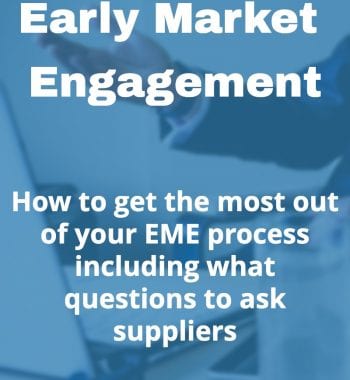 While there has been a tendency towards agile principles and approaches within procurement in recent years – often to compensate for unknown ‘unknowns’ at the outset of a project – in complex strategic projects it is usually far more cost and time effective to opt for an early market engagement-based strategy.
While there has been a tendency towards agile principles and approaches within procurement in recent years – often to compensate for unknown ‘unknowns’ at the outset of a project – in complex strategic projects it is usually far more cost and time effective to opt for an early market engagement-based strategy.
Spending more time with a supplier at the outset of your relationship, tapping into their industry knowledge, to ensure that everything from the realistic attainability of a project’s ultimate business outcomes to gaining a better understanding of both the business outcomes, requirements and contractual mechanisms that will drive the right behaviours from both parties to achieve them, is always a good thing in these circumstances. And this was one of the fundamental tenets at the heart of a recent NAO report on The challenges in implementing digital change.
The report recognised that while the issues around major digital change projects have been known for decades, not much has changed in all of that time to move government processes and actions in a direction that has resulted in a material improvement in the success rates for such projects.
For example, complex technology transformation programmes fail for a whole host of reasons so what’s needed is a different approach at a more foundational level.
And that’s what this series of articles on that NAO report have been about – the importance of fit-for-purpose flexible contracts, the creation of a sound business case, the use of an Intelligent Client Function team, and now the reasons why early market engagement with suppliers is vital to the success of your business change project.
What is ‘early market engagement’?
The decisions you make at the early stages of a complex or high-risk business change project will have a significant impact on the chances of it delivering your business objectives.
Early market engagement is where you go out into the specialist supplier market and start a dialogue with a number of prospective suppliers. This dialogue is all about drawing on their business and technological expertise in order to fill any gaps in your understanding to improve the quality of both your expectations and the procurement process and aid in determining which collaborative partner you should work with to help you achieve your business objectives.
In other words, ‘Informed early market engagement will help you assess whether your project expectations, timescales, resources and budget are realistic and achievable.’
This should also all be part of a supplier’s due diligence process. Recent case law has provided a foundation which puts most specialist suppliers under an implied contractual duty for checking that your expectations of them are realistic and that any gaps in your brief or your understanding are identified, and that they expressly warn you about them. This is so that they can outline their approach to close and/or mitigate those gaps in order that they can properly determine whether the solutions they have the capacity to deliver will meet your expectations. And all this is important because should this not be the case, they have a duty of care to warn you about the resulting potential consequences.
It is, therefore, important that your supplier:
-
- Makes it expressly clear that they understand the outcomes you wish them to achieve with and for you;
- Has clear visibility of your business objectives;
- Fully appreciates your current operating state and the future operating state you expect their solution to get you to; and
- Knows its ‘expert’ responsibilities and lives up to its express ‘duty to warn’ you about any ambiguities or errors in the information you bring to them which may impact on their ability to determine the correct solution for your project/programme.
For public sector readers: This sounds a lot like Competitive Dialogue (CD)
Competitive Dialogue is a public sector tendering procedure which encourages early market dialogue between client organisations and suppliers for exactly the reasons noted above: to reduce the risks inherent in any complex or high-risk project.
Competitive Dialogue should be considered if the project you’re looking to embark on will make a material change to the way you operate or where it would be sensible to expect your supplier to undertake some due diligence to ensure that its solution will be fit for purpose. However, launching into a CD process without having first undertaken an appropriately detailed Early Market Engagement process is not advisable. You should have a good understanding of the spectrum of your achievable requirements, expectations, budgets and timescales well before undertaking a CD process, so that the CD process itself is both time and cost effective.
NAO report recommendations
After an assessment of many other reports on the subject and consultations across government and its commercial suppliers, the NAO came up with nine action points, one of which was to ‘carry out proper evaluation and assurance in the early stages of a digital programme to understand its complexity and scope, assess how realistic the chance of success is and reflect this in the programme approach’.
It also acknowledged the importance of recognising what each party brings to the table, to respect everyone’s relevant expertise and to work collaboratively to achieve the best results through combining this expertise in the right way to minimise misunderstandings, maximise innovative thinking and drive the right behaviours on any digital change project.
At the time of the compilation of this report, the government’s Major Projects Portfolio, many of which involved digital transformation elements, had 125 live projects running worth approximately £448 billion, so the stakes could not be higher.
What happens without early market engagement?
While there will be a wide variety of reasons for issues in projects, one of the most visible challenges a more poorly considered project or a misaligned relationship may face is schedule slippage. In the NAO report one of tables shows the original and actual/current expected completion dates for ten major government projects. Below is an extract from that table.
| PROJECT | ORIGINAL COMPLETION DATE | ACTUAL/EXPECTED COMPLETION DATE | YEARS DELAY |
|---|---|---|---|
| E-borders | 2011 | Cancelled | Cancelled |
| GOV.UK Verify | 2012 | 2016 | 4 years |
| New Generation Electronic Monitoring | 2013 | 2019 | 6 years |
| Common Agricultural Policy Delivery | 2015 | 2016 | 1 year |
| Emergency Services Network | 2017 | 2024 | 7 years |
| Universal Credit | 2017 | 2024 | 7 years |
| Crossrail (central section) | 2018 | 2022 | 4 years |
| Digital Services at the Border | 2019 | 2022 | 3 years |
| Smart Meter National Programme | 2019 | 2025 | 6 years |
| Her Majesty’s Courts & Tribunals Service Courts and Tribunals Reform Programme | 2022 | 2023 | 1 year |
A further table referred to the increased costs and reduced benefits of a number of these projects.
| PROJECT | INCREASED COSTS | REDUCED BENEFITS |
|---|---|---|
| Common Agricultural Policy Delivery | Costs increased by £60m (from £155m to £215m), an increase of just under 40% | Original benefits were expected to be in the region of £274m. It is unclear how much will now be made |
| Emergency Services Network | Costs increased by £3.1bn (from £6.2bn to £9.3bn), and increase of 50% | Benefits have decreased from an original expected £3.6bn to a current estimate of around £1.5bn. A decrease of £2.1bn |
| Digital Services at the Border | Costs have increased by £172m on this project | At the same time, benefits have fallen by £51m (from £62m to just £11m) |
| Smart Meter National Programme | Most recent estimates put the cost increase at £500m over the £11bn originally estimated | With expected benefits reducing by a billion pounds |
| Her Majesty’s Courts & Tribunals Service Courts and Tribunals Reform Programme | Costs here have increased by £64m | Benefits have fallen by £172m (from an original estimate of £2.3bn) |
The NAO report highlighted an example that we feel represents what can happen when not enough forethought is invested into a project.
Case example: The new generation electronic monitoring programme, 2017
The Ministry of Justice’s requirements for ‘world‑leading’ ankle tags for monitoring offenders proved too difficult to implement.
Main department: Ministry of Justice (the Ministry)
Objective: The Ministry launched a programme to develop a new ‘world-leading’ ankle tag for offenders, combining both radio frequency and GPS functionality. The tags aimed to store and send more location data than existing tags in the market, meet higher data security standards, and be reliable and robust. They also aimed to be compact enough to wear comfortably and not require continual recharging.
What happened: The Ministry signed the contract to develop the tags in August 2012 and expected to deploy them from November 2013. The bespoke requirements proved too ambitious to implement, resulting in serious delays and parting company with two successive suppliers.
Outcome: The Ministry decided to procure existing GPS tags that were already available in the market and began to deploy these in 2018, five years later than planned.
What lessons departments can learn: Departments should avoid unrealistically ambitious plans to use untested technology at scale.
Source: Comptroller and Auditor General, The new generation electronic monitoring programme, Session 2017–2019, HC 242, National Audit Office, July 2017
The report stated that:
‘If departments do not think sufficiently up-front about the complexities of a digital programme, they risk failing to meet the business need or needing to de-scope or abandon programmes as understanding grows. Digital leaders told us programme teams often rush to a solution because of pressure to deliver quickly, and do not spend enough time understanding the business need, the existing system or what business improvement the programme team wants to deliver.’
Insufficient scoping and/or planning will often result in exactly what we have highlighted above: increased costs, reduced benefits and lengthened timelines.
To borrow again from the NAO report: ‘… our evidence shows departments have not spent enough time exploring requirements with commercial partners at an early-enough stage. Early discussions with a range of suppliers before settling on a solution can help departments to de-risk programmes and explore what is possible. Lengthening that early engagement can improve collaboration, facilitate innovation and improve quality requirements’.
Conclusion
Digital change programmes have the capacity to offer significant benefits, no matter whether they are for the public or private sector, as the rate of technological advancement accelerates.
However, just as they offer the potential of significant benefits they can also become costly mistakes if not enough time is invested into building a thorough understanding of your needs, the problems you are looking to solve, and the outcomes you are looking to achieve with the help of your supplier partners.
Early market engagement is one of the missing links in the procurement chain in many failed complex projects, especially those of a digital nature. It helps you to tap into the vast experience contained in supplier organisations and to develop the beginnings of the collaborative relationship you will need to foster in order to give your digital change project the best possibility of success.

